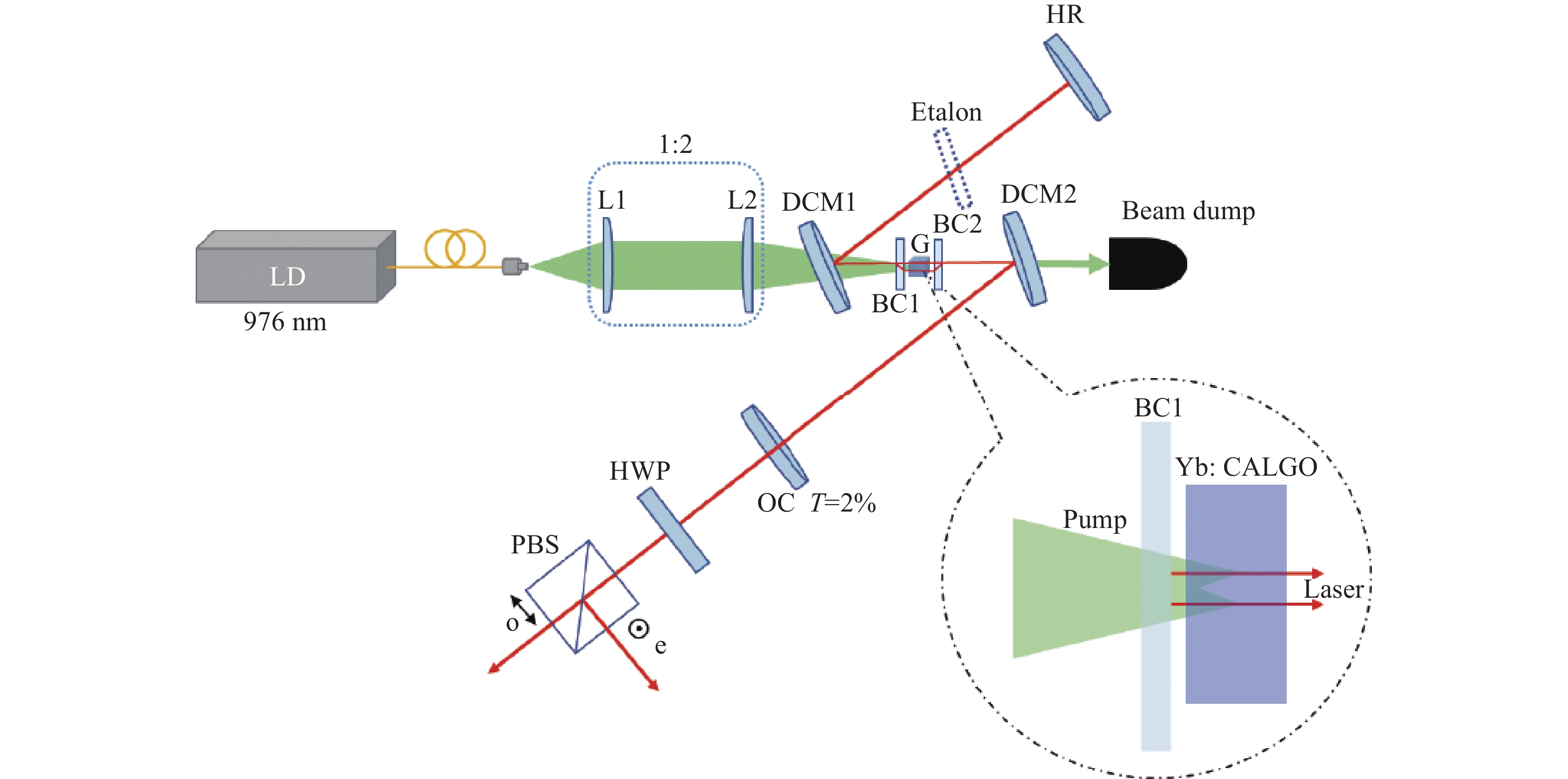Polarization-multiplexing of a laser based on a bulk Yb:CALGO crystal
doi: 10.37188/CO.EN-2023-0005
-
摘要:
基于大增益带宽和高热导率晶体的偏振复用激光技术可以提高双频激光器和双光梳激光器在输出光谱范围和功率方面的性能。本文提出一种基于Yb:CALGO晶体的偏振复用激光器。将两片与光轴成45°角切割的双折射晶体放置在增益晶体的前后两侧形成三明治结构,利用双折射晶体的偏振特性使腔内激光形成只在三明治结构部分具备空间分离其余部分共线的偏振方向互相垂直的两种模式。同时,这种三明治结构既能使单束泵浦光能够自动分离为两束空间分离匹配的泵浦光,也可以使腔内增益晶体放置在腔内模式腰斑位置处,与泵浦光达到更好的模式匹配,提高光泵浦效率。最终测得的激光输出功率达到瓦量级并且斜率效率超过30%。在腔内加入标准具后,实现了频差为太赫兹量级的稳定双频激光运转。
-
关键词:
- 偏振复用 /
- Yb:CALGO晶体 /
- 双频激光器 /
- 双波长激光器 /
- 双梳激光器
Abstract:The polarization-multiplexing of a laser based on a medium with a large gain bandwidth and a high thermal conductivity can benefit dual-frequency and dual-comb lasers’ spectral bandwidth and power. This paper presents a demonstration of the polarization-multiplexing of a laser based on a bulk Yb:CALGO crystal. The polarization multiplexing is realized by sandwiching the gain crystal with two birefringent crystals which are cut at 45˚ to their optical axis. This sandwich-configuration creates inside the cavity two orthogonally polarized beams which are spatially separated only in the sandwich-configuration part but collinear in other part. Meanwhile, a single pump beam is also split into two beams automatically, matching the two cavity modes. This configuration also allows the gain crystal to be located in at the waist of cavity modes, which benefits the pumping efficiency. The laser outputs watt-level power with a slope efficiency exceeding 30%. A dual-frequency operation with terahertz frequency separation is realized by inserting an etalon into the cavity.
-
Figure 1. Schematic of the laser polarization-multiplexed by sandwiching a Yb:CALGO crystal with two birefringent crystals. LD: fiber-coupled laser diode; DCM1, DCM2: dichroic mirrors; G: Yb:CALGO cryatal; BC1, BC2: birefringent crystals made of YVO4; HR: high reflection concave mirror with a curvature radius of 150 mm; OC: output coupler with a curvature radius of 150 mm; L1, L2: lenses; HWP: half-wave plate; PBS: polarization beam splitter
-
[1] BAILI G, MORVAN L, ALOUINI M, et al. Experimental demonstration of a tunable dual-frequency semiconductor laser free of relaxation oscillations[J]. Optics Letters, 2009, 34(21): 3421-3423. doi: 10.1364/OL.34.003421 [2] PILLET G, MORVAN L, BRUNEL M, et al. Dual-frequency laser at 1.5 µm for optical distribution and generation of high-purity microwave signals[J]. Journal of Lightwave Technology, 2008, 26(15): 2764-2773. doi: 10.1109/JLT.2008.927209 [3] PAQUET R, BLIN S, MYARA M, et al. Coherent continuous-wave dual-frequency high-Q external-cavity semiconductor laser for GHz-THz applications[J]. Optics Letters, 2016, 41(16): 3751-3754. doi: 10.1364/OL.41.003751 [4] PUPEIKIS J, WILLENBERG B, CAMENZIND S L, et al. Spatially multiplexed single-cavity dual-comb laser[J]. Optica, 2022, 9(7): 713-716. doi: 10.1364/OPTICA.457787 [5] WILLENBERG B, PUPEIKIS J, KRÜGER L M, et al. Femtosecond dual-comb Yb: CaF2 laser from a single free-running polarization-multiplexed cavity for optical sampling applications[J]. Optics Express, 2020, 28(20): 30275-30288. doi: 10.1364/OE.403072 [6] LIAO R Y, TIAN H C, LIU W, et al. Dual-comb generation from a single laser source: principles and spectroscopic applications towards mid-IR—A review[J]. Journal of Physics:Photonics, 2020, 2(4): 042006. doi: 10.1088/2515-7647/aba66e [7] DUMONT P, CAMARGO F, DANET J M, et al. Low-noise dual-frequency laser for compact cs atomic clocks[J]. Journal of Lightwave Technology, 2014, 32(20): 3817-3823. doi: 10.1109/JLT.2014.2318179 [8] SCHELLER M, YARBOROUGH J M, MOLONEY J V, et al. Room temperature continuous wave milliwatt terahertz source[J]. Optics Express, 2010, 18(26): 27112-27117. doi: 10.1364/OE.18.027112 [9] CODDINGTON I, NEWBURY N, SWANN W. Dual-comb spectroscopy[J]. Optica, 2016, 3(4),doi: 10.1364/optica.3.000414. [10] SUH M G, VAHALA K J. Soliton microcomb range measurement[J]. Science, 2018, 359(6378): 884-887. doi: 10.1126/science.aao1968 [11] ZHANG P, MAO L, ZHANG X J, et al. Compact dual-wavelength vertical-external-cavity surface-emitting laser with simple elements[J]. Optics Express, 2021, 29(11): 16572-16583. doi: 10.1364/OE.423074 [12] MANJOORAN S, LOIKO P, MAJOR A. A discretely tunable dual-wavelength multi-watt Yb: CALGO laser[J]. Applied Physics B, 2018, 124(1): 13. doi: 10.1007/s00340-017-6873-x [13] SCHELLER M, BAKER C W, KOCH S W, et al. High power dual-wavelength VECSEL based on a multiple folded cavity[J]. IEEE Photonics Technology Letters, 2017, 29(10): 790-793. doi: 10.1109/LPT.2017.2685595 [14] GREDAT G, LIU H, COTXET J, et al. Optimization of laser dynamics for active stabilization of DF-VECSELs dedicated to cesium CPT clocks[J]. Journal of the Optical Society of America B, 2020, 37(4): 1196-1207. doi: 10.1364/JOSAB.389310 [15] LINK S M, MAAS D J H C, WALDBURGER D, et al. Dual-comb spectroscopy of water vapor with a free-running semiconductor disk laser[J]. Science, 2017, 356(6343): 1164-1168. doi: 10.1126/science.aam7424 [16] KOWALCZYK M, STERCZEWSKI Ł, ZHANG X ZH, et al. Dual-comb femtosecond solid-state laser with inherent polarization-multiplexing[J]. Laser &Photonics Reviews, 2021, 15(8): 2000441. [17] MANJOORAN S, MAJOR A. Diode-pumped 45 fs Yb: CALGO laser oscillator with 1.7 MW of peak power[J]. Optics Letters, 2018, 43(10): 2324-2327. doi: 10.1364/OL.43.002324 [18] HAKOBYAN S, WITTWER V J, BROCHARD P, et al. Full stabilization and characterization of an optical frequency comb from a diode-pumped solid-state laser with GHz repetition rate[J]. Optics Express, 2017, 25(17): 20437-20453. doi: 10.1364/OE.25.020437 [19] KLENNER A, GOLLING M, KELLER U. High peak power gigahertz Yb: CALGO laser[J]. Optics Express, 2014, 22(10): 11884-11891. doi: 10.1364/OE.22.011884 [20] PETIT J, GOLDNER P, VIANA B. Laser emission with low quantum defect in Yb: CaGdAlO4[J]. Optics Letters, 2005, 30(11): 1345-1347. doi: 10.1364/OL.30.001345 [21] MODSCHING N, PARADIS C, LABAYE F, et al. Kerr lens mode-locked Yb: CALGO thin-disk laser[J]. Optics Letters, 2018, 43(4): 879-882. doi: 10.1364/OL.43.000879 -






 下载:
下载:





